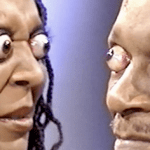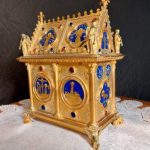 Animals
Animals  Animals
Animals  Weird Stuff
Weird Stuff 10 Weird Things People Used to Do at New Year’s
 Our World
Our World 10 Archaeological Discoveries of 2025 That Refined History
 Weird Stuff
Weird Stuff 10 Fascinating Facts You Might Not Know About Snow
 Miscellaneous
Miscellaneous Top 10 Things Crypto Was Supposed to Change & What Actually Did
 History
History 10 Huge Historical Events That Happened on Christmas Eve
 Music
Music 10 Surprising Origin Stories of Your Favorite Holiday Songs
 History
History 10 Less Than Jolly Events That Occurred on December 25
 Weird Stuff
Weird Stuff 10 Funny Ways That Researchers Overthink Christmas
 Politics
Politics 10 Political Scandals That Sent Crowds Into the Streets
 Animals
Animals 10 Species That Refused to Go Extinct
 Weird Stuff
Weird Stuff 10 Weird Things People Used to Do at New Year’s
 Our World
Our World 10 Archaeological Discoveries of 2025 That Refined History
Who's Behind Listverse?

Jamie Frater
Head Editor
Jamie founded Listverse due to an insatiable desire to share fascinating, obscure, and bizarre facts. He has been a guest speaker on numerous national radio and television stations and is a five time published author.
More About Us Weird Stuff
Weird Stuff 10 Fascinating Facts You Might Not Know About Snow
 Miscellaneous
Miscellaneous Top 10 Things Crypto Was Supposed to Change & What Actually Did
 History
History 10 Huge Historical Events That Happened on Christmas Eve
 Music
Music 10 Surprising Origin Stories of Your Favorite Holiday Songs
 History
History 10 Less Than Jolly Events That Occurred on December 25
 Weird Stuff
Weird Stuff 10 Funny Ways That Researchers Overthink Christmas
 Politics
Politics 10 Political Scandals That Sent Crowds Into the Streets
10 Bad Hombres Whose Body Parts Became Souvenirs
Go to Europe, and you’ll discover that many ancient churches contain relics, e.g. bones or other body parts of long-gone saints. Many Americans regard the veneration of relics as a quaint or even macabre Old World custom. However, they do the same thing.
In the US, though, they don’t save bits and pieces of holy men. Instead, they go for the tough, mean types—gunslingers, gangsters, assassins, and serial slayers. They collect their skin and skulls and ears and fingers, as you’ll see in this list of bad hombres whose body parts have become precious keepsakes.
10 Blackbeard’s Skull

In the early 1700s, Blackbeard (real name: Edward Teach) and his pirate crew plundered ships and seaports on the Atlantic coast from Virginia to Georgia. In 1718, frustrated merchants reached out to the governor of Virginia for help.
He dispatched a British naval force to Ocracoke Island off North Carolina, rumored to be Blackbeard’s hideout. Sure enough, the navy found the pirate’s ship moored offshore. The British hid belowdecks to lure the pirates onto their ship and then attacked. Blackbeard, swinging a heavy cutlass, proved to be a fierce fighter. After he fell dead, the Navy crew examined his body and found five pistol wounds and 20 lacerations. They then cut off his head and hung it from their bowsprit. According to legend, when they tossed the headless corpse overboard, it swam around their ship five times before sinking.
Back in Virginia, Blackbeard’s head was hung from a post on Tindall’s Point on the Rappahannock River as a warning to other pirates. According to legend, the skull was later taken down and used to make a silver-mounted drinking cup. The cup even had a nickname, “the Infant.” North Carolina historian Charles Whedbee claimed the gruesome mug eventually wound up in an Ocracoke tavern and that he drank from it in the 1930s. Later, there were stories that a college fraternity acquired the cup and used it in their initiation rites, though no one is certain which college that was.[1]
A skull believed to be Blackbeard’s later fell into the hands of New England author Edward Rowe Snow, an expert on maritime lore. Snow often gave talks to Rotarians, Boy Scouts, and such, and he usually brought along a collection of ancient daggers and flintlocks allegedly once used by pirates. The stockpile typically included the skull, and Snow would allow Scouts to hold it and pass it around.
After Snow’s death, his widow passed his collection, including the skull, to the Peabody Essex Museum in Salem, Massachusetts. The museum curator keeps the skull in a storage room. She claims no one knows for sure if it once sat on Blackbeard’s shoulders. Occasionally, it is loaned to the North Carolina Museum of History.
9 John Murrell’s Thumb

In 1823, a Tennessee posse arrested small-time scoundrel John Murrell. A court sentenced him to lashing, several years behind bars, and branding. The letters “HT,” for “horse thief,” were seared on his thumb.
In 1834, he was arrested again by bounty hunter Virgil Stewart. On Stewart’s testimony, Murrell was convicted of stealing a slave and again sentenced to imprisonment. He was released in 1844, repentant, broken, and in poor health. He died later that year.
The story would have ended there, were it not for Stewart’s fevered imagination. He penned a fabulous book in which he claimed Murrell led a gang of more than 1,000 men (the Mystic Clan) who stole horses and slaves, robbed highway travelers, and littered the Mississippi Delta with their victims’ corpses. What’s more, he wrote that they planned to instigate a massive slave insurrection that would leave the South in chaos and allow criminals to rule. Stewart also stated he had single-handedly saved the day by infiltrating the gang, taking notes at their meetings, and bringing Murrell to justice.
Not only was the book was a hit, but it sparked a panic across the South. The “Murrell Excitement” spurred posses to arrest scores of men, both black and white, who allegedly were part of the conspiracy. Some were whipped, some were driven from their homes, and some were hanged.
The imprisoned Murrell missed the mania. But when he died, his new notoriety as the Lex Luthor of the South meant his body could not rest easy. Grave robbers unearthed the corpse, cut off the head, and exhibited it at county fairs for ten cents a peek. Eventually, the head disappeared, but the ghouls held on to another snipped part—the branded thumb.
Today, Murrell’s dried and mummified thumb resides in the Tennessee State Museum in Nashville. It’s displayed only during Halloween season. The digit is kept in a box described by one reporter as a “cute little coffin” and is said to resemble a Tootsie Roll.[2]
8 Jules Beni’s Ears
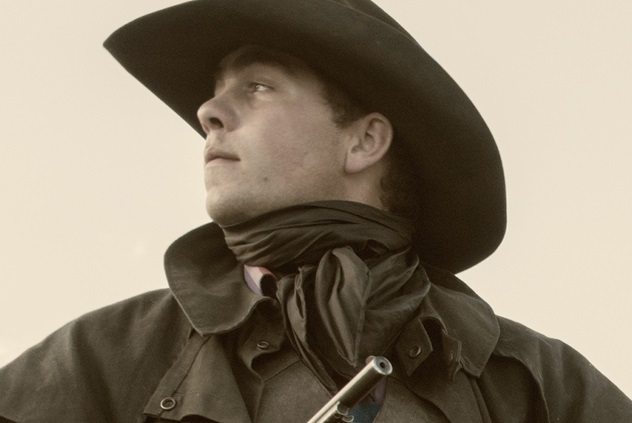
Julesburg, Colorado, was founded by Jules Beni (sometimes called Reni or Remi), a burly French-Canadian who did not always live within the law. He built a restaurant and saloon and then became a stationmaster for the Central Overland stagecoach line. Unfortunately, he was caught pilfering company livestock, which, naturally, irked management. In 1858, they hired a new stationmaster, Jack Slade, a Mexican War veteran and notorious gunfighter.
Beni was determined to drive his replacement out of town. He ambushed Slade, shooting him three times with a pistol and then firing a shotgun blast. Watching Slade tumble to the ground, Beni dryly remarked, “There’s an empty crate in the barn. You can bury him in it.”
But Slade didn’t die. According to legend, as he lay on the ground, he vowed he would survive and someday decorate his watch chain with Beni’s ears.
Slade did recover, and he went hunting for revenge. He found the Frenchman playing cards in a local saloon and pulled a gun on him. He then had station workers tie Beni to a corral post. Slade spent the afternoon drinking and torturing his enemy by shooting his arms and legs. At sundown, he killed Beni with a bullet to the head.
Another version of the story says Beni was shot and wounded by stage line employees. They brought him back to town to collect a reward Slade had offered. Beni was tied to a post in a sitting position, but by then, no one could say whether he was alive or dead. Slade used his gun to make certain.
Both stories end the same way: Slade reportedly cut the ears off the dead body. He nailed one to the corral post as a warning to others to stay on his good side. In keeping with his revenge vow, he attached the other to his watch chain. To horrify drinking companions, he often pulled out the grisly watch fob while relaxing in saloons.
Slade became notorious throughout the West as the man with an ear in his pocket. In his book Roughing It, author Mark Twain recalled meeting the gunfighter during a trek through the western states. Though Slade was gracious and polite, Twain noted he had killed 26 men, and he was glad to get away without becoming Number 27.[3]
7 William Clarke Quantrill’s Skull And Bones
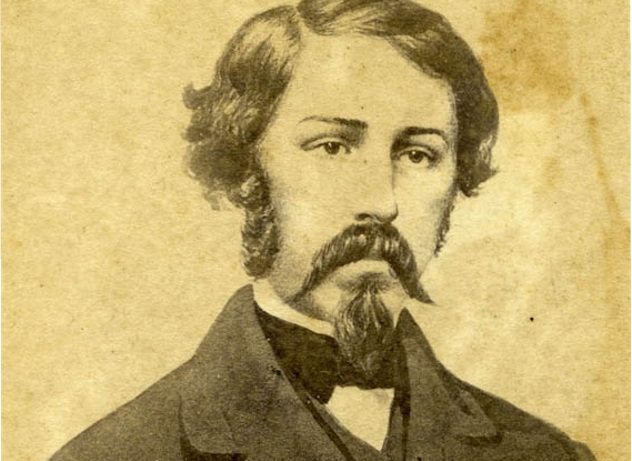
During the US Civil War, troops weren’t always led by distinguished generals like Grant and Lee. In Kansas and Missouri, then a frontier region, settlers on both sides formed civilian militias led by self-appointed officers who were often little more than bandits. They avoided the battlefield and instead raided undefended towns and farms, where they engaged in robbery and revenge murder. The most infamous of these men was William Clarke Quantrill, who led a band of Confederate sympathizers that included Frank and Jesse James and many of those who would later ride with their outlaw gang.
In August 1863, Quantrill gathered together most of Missouri’s guerillas and led a force of 450 toward Lawrence, Kansas, known as a stronghold of Union support. There were no troops stationed in Lawrence, so Quantrill’s raiders were able to run amok. They torched most of the buildings, plundered homes and businesses, and executed more than 180 men and boys.
Two years later, as the war came to a close, Quantrill was shot and killed near Louisville, Kentucky. By then, he’d been deserted by most of those who rode with him to Lawrence. All the same, after the war, many Missourians came to see him as a folk hero, despite his murderous record.
Because Quantrill died outside Missouri, his remains were not treated with reverence. His body was first buried in an unmarked grave in Louisville. In 1887, Quantrill’s widowed mother convinced neighbor William Scott to help her retrieve his bones and bring them to Dover, Ohio, his hometown, where he could rest in peace alongside deceased family members. Scott found the Louisville grave and paid a gravedigger to open it. Most of Quantrill’s corpse had decomposed by then, but Scott was able to gather a few bones and the skull, identified by a chipped tooth.
Some fragments were indeed buried in Ohio. But Scott quietly held onto the skull and a few bones, as he thought they might be worth money to collectors of Civil War memorabilia. He sent two shinbones and a tuft of hair to the Kansas Historical Society, hoping to stir up interest in the skull, but had no success.[4]
After Scott’s death, his son gave the skull to a fraternal group. The frat boys shellacked it and named it “Jake.” New members were made to touch it while reciting an initiation oath. In 1972, the last surviving club member handed the skull to the Dover Historical Society.
By the 1980s, Civil War buffs in Missouri had gotten wind that parts of Quantrill’s body were being kept as souvenirs. They launched a campaign to get them back. In 1992, the Kansas Historical Society turned over their small collection of Quantrill bones, and they were buried in a Confederate cemetery in Missouri, with Civil War reenactors providing pomp and ceremony. The skull, though, stayed in Ohio, and was buried in the Quantrill family plot. That means the old raider’s bones now molder in three graves many miles apart.
Today, the only Quantrill relic still above the ground is a wax replica of his head, created by anthropology students using a casting of the skull. The Dover Historical Society keeps it in a refrigerator, alongside a ketchup bottle. The staff have named it Bill, and they take it out for parties.
6 The Skin And Skull Of Big Nose George
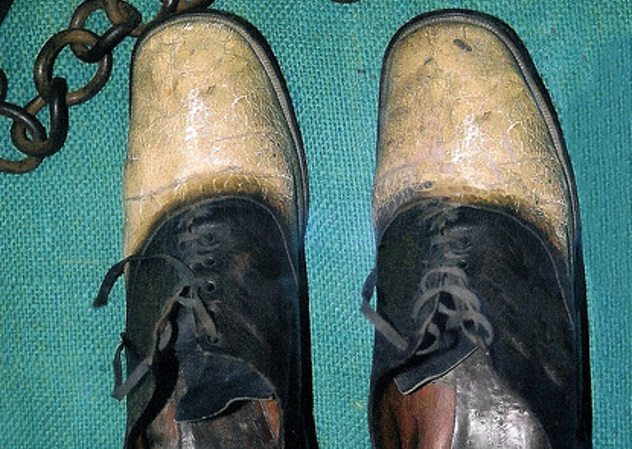
An unusual pair of two-tone shoes are displayed in the Carbon County Museum in Rawlins, Wyoming. They’re made from the hide of Wild West desperado Big Nose George Parrot, and they once lent sartorial splendor to the state’s governor as he danced at his inaugural ball.
Back in the 1870s, Big Nose George led a gang of rustlers and stagecoach robbers who terrorized the state. In 1878, they tried robbing a Union Pacific train but bungled the job and fled to Montana empty-handed, with a posse in hot pursuit. When two Wyoming lawmen stumbled on the outlaws’ camp, the gang opened fire, killing both.[5]
In 1880, Big Nose George landed in Miles City, Montana, where he spent his loot in the saloons. Someone heard him bragging about his criminal exploits—including the murders—and wired the sheriff in Carbon County, Wyoming. He soon had the outlaw in custody.
Back in Rawlins, Big Nose was tried, convicted, and sentenced to hang. Ten days before the scheduled execution, however, word spread through town that the outlaw had tried to escape. A lynch mob broke into the jail and dragged Big Nose out to the street. Someone tossed a rope over a telegraph pole, and a moment later, the killer was swinging from a noose.
More than 200 people watched, including two local doctors, John Osborne and Thomas Maghee. They claimed the corpse for medical study. Back in their lab, they sawed off the top of the skull so that they could examine the brain. After that, the dissection took a freakish turn. Osborn skinned the hide from the chest and thighs, tanned it, and took the man-leather to a cobbler. Big Nose became a pair of shoes and a medical bag.
You might think the doctor would be shunned for such ghoulish behavior, but you’d be wrong. In 1897, he was elected governor of Wyoming. He wore the skin shoes to his inauguration and received several compliments. The governor, however, always responded with gripes about the shoemaker’s shoddy work: Osborne had instructed him to put the nipples on the toes (tres chic!), but they were nowhere to be seen.
As for the skull cap, Osborne presented it to his teenage assistant, Lillian Heath. She later became Wyoming’s first woman doctor. (She made house calls dressed as a ranch hand and toting a six-gun.) She kept the skull cap for decades, using it as a doorstop and an ashtray.
The skin shoes are now in the Rawlins museum, along with a plaster death mask and the lower part of the skull. The skull cap is in the Union Pacific Historical Museum in Omaha.
5 Ted Williams’s Head
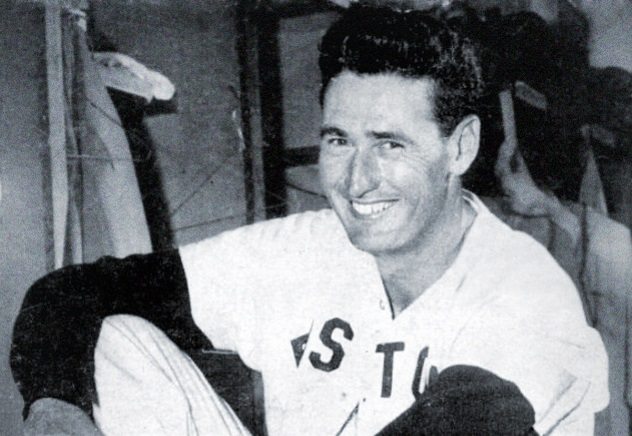
During his career with the Boston Red Sox from 1939 to 1960, the late Ted Williams led the American League in home runs four times. He was also a war hero who interrupted his baseball career to fly combat missions for the Marines during the Korean War.
Back his baseball days, however, Williams wasn’t always seen as a hero. He spit at fans and saluted them with a middle finger. He cursed at sports writers. He sometimes insisted on giving interviews from behind a closed door. In short, he behaved like a world-class jerk.
“If his noodle swells another inch, Master Ted Williams [ . . . ] won’t be able to get his hat on with a shoehorn,” wrote a sports reporter for the New York Post. “When it comes to arrogant and ungrateful athletes, this one leads the league.”
For those reasons, Williams can accurately be labeled a bad hombre.
Many fans were nonetheless outraged after his death in 2002 when they learned what had become of his remains. John Henry Williams, his son, shipped Ted’s corpse to Alcor Life Extension Foundation in Scottsdale, Arizona, an organization that freezes dead bodies with the promise they will be thawed and brought back to life when such technology exists.[6] The controversial practice is known as cryonics.
According to a Sports Illustrated expose, Williams had argued with his son when told about the cryonics plan. He allegedly asked to be cremated, with his ashes spread over his favorite fishing grounds.
Later news stories reported Alcor technicians had removed Williams’s head from his body. The organization has a theory that eventually, biotechnology will allow them to regrow the whole body from the brain stem. And according to one Williams biographer, John Henry told his siblings they might someday make money selling their dad’s DNA for cloning “little Ted Williamses.”
In a 2009 book, a disgruntled Alcor employee alleged that Ted’s noggin had once become frozen to an empty tuna can that was used as a headstand. In an effort to knock the can loose, an Alcor technician allegedly grabbed a monkey wrench, and—like Williams himself—took a mighty swing. He missed, struck the head, and sent bits of frozen flesh flying across the room. Alcor has denied the story.
4 Lee Harvey Oswald’s Bloodstain And Hair

Lee Harvey Oswald will always be an enigma. A government report has labeled him the gunman who assassinated President John F. Kennedy. At the same time, a legion of skeptics question whether he really was the shooter or whether he acted alone.
Here are the facts: On November 22, 1963, crowds gathered around Dealey Plaza in Dallas, Texas, to watch the presidential motorcade pass through. Shortly after noon, as the president and first lady passed by in an open limousine, three shots rang out. Two bullets hit JFK. The limo driver raced to Parkland Memorial Hospital, but doctors there could not save the president.
Witnesses said the shots came from the Texas School Book Depository, a tall building overlooking Dealey Plaza. And some saw Lee Harvey Oswald, a 24-year-old ex-Marine turned ardent communist, fleeing the scene. Police soon arrested him in a movie theater.
Oswald never stood trial. Two days later, as police led the suspect from a station house for transportation to a jail, nightclub owner Jack Ruby stepped forward and fired a .38 revolver. Oswald died with a bullet in his gut.
The passing decades have seen a brisk trade in assassination memorabilia. In 1994, an Internet auction house announced Oswald’s mortuary toe tag—with his blood smeared across it and a lock of hair attached—would be up for sale.
Dave Ryan, a popular morning DJ in Minnesota, phoned in the winning bid: $8,800. “I’m just really into history,” Ryan told the Chicago Tribune. “I just look at this as an investment.”
A few years later, Ryan sold the bloody tag and hair to the Ripley’s Believe It Or Not! Odditorium in San Antonio. The tourist trap’s display includes a card explaining that the hair was snipped by a hospital nurse. The Odditorium exhibit also includes furniture from Oswald’s apartment, a car he rode in on the day of the assassination, mortician’s tools used to embalm his corpse, and his fingerprints from police department files.[7]
What’s hard to believe is that anyone would want to see such things.
3 Gene Simmons’s Blood
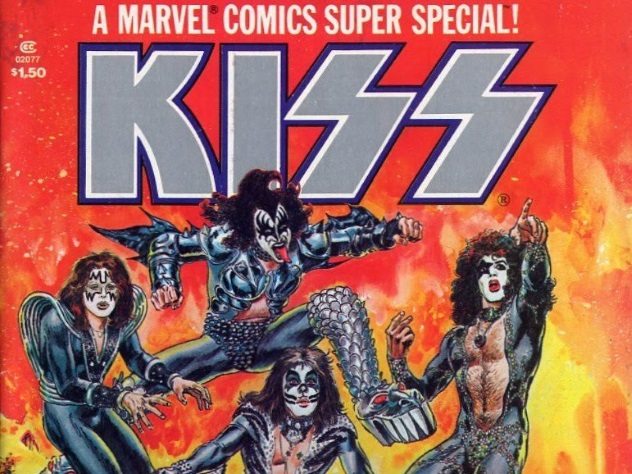
Offstage, Gene Simmons is probably a pretty nice guy. He’s even a philanthropist. But when he takes the stage to play bass with the rock band KISS, he’s definitely a bad hombre. He wags his tongue, breathes fire, spits fake blood, and dresses in studded black leather and demonic face makeup.
He once he appeared on The Mike Douglas Show in full costume. “What are you?” Douglas asked. Replied Simmons, “What I am is evil incarnate.”
In the mid-1970s, when KISS albums went gold and the arena shows sold out, the band also raked in money hawking a mile-long line of souvenir merchandise. There were posters, action figures, lunch boxes, cigarette lighters, and even a KISS coffin. (The late Darrell Abbott, lead guitarist for Pantera, was buried in one.)
As the members of KISS already looked like comic book figures, it seemed only right that their merchandise line would eventually include comic books. Marvel Comics, home to Spider-Man, Iron Man, Captain America, and Thor, added KISS to their roster of pulp-page protagonists. In May 1977, the company published KISS Super Special, a 40-page magazine and comic book that featured the four musicians as superheroes.
To hype the launch of their comic book, Simmons and his fellow band members hatched a gruesome publicity stunt. Before a concert at Long Island’s Nassau Coliseum, the four lined up in full costume to have a registered nurse draw a vial of blood from each. Photographers snapped pictures, and a notary witnessed the bloodletting.
After the show, the four boarded a plane and flew to Depew, New York, where Marvel comics are printed. In the printing plant, again with a gaggle of press looking on, each poured his vial into a vat of red ink. They then announced fans would be able to purchase a book printed with their own blood.[8]
“A thousand years from now, when humanity is extinct and aliens finally land on this planet, they’ll be able to repopulate the Earth with human beings because of KISS comics,” Simmons said in an interview in 2016. “Think about it: you just go in there, get the DNA, and of course they’ll all look like me.”
The comic book, priced at $1.50, was a sellout. Today, copies sell on Amazon for $499.99.
2 John Wayne Gacy’s Brain

In the early hours of December 22, 1978, John Wayne Gacy sat in a police station confessing that he’d killed dozens of boys and young men. There was really nothing else he could do. In the crawl space of his home in a Chicago suburb, police had unearthed a ghastly trove of decaying corpses. The body count eventually reached 33.
During Gacy’s 1980 trial, arguments focused on his mental state. Psychiatrists devoted hundreds of hours to probing his mind. One even filled him up with scotch to see if alcohol transformed him into a fiend. In the end, jurors convicted Gacy, and the judge handed down a death sentence. He spent nearly 14 years on death row before his 1994 execution by lethal injection.
While Gacy awaited his date with the needle, psychiatrist Helen Morrison got the notion that his brain should be studied for clues as to why serial killers do what they do. He agreed. She showed up at his autopsy with a notorized letter from Gacy’s sister, his closest relative, instructing doctors to entrust her with his grey matter.
Today, Gacy’s brain sits in the basement of the Morrison family home. The doctor cut it in slices, like a meatloaf, and deposited each piece in a Ziploc bag, along with a preservative. From time to time, other researchers have asked to examine the head meat, and Morrison has obliged their requests. As yet, however, science has turned up no defects that might explain Gacy’s freakish behavior.
“There’s actually nothing abnormal,” Morrison told the Chicago Tribune. “No tumor, no growth, no sign of any injuries.”[9]
From time to time, nonprofessionals have asked to see the brain, too, and on at least one occasion, Morrison said yes. Of course, that request came from a deep-thinking genius—Khloe Kardashian.
It seems Khloe has always been fascinated with serial killers. In 2010, a media producer arranged for her to visit Morrison’s home for a peek at his skull gunk. With cameras rolling, Khloe raised her dainty fingers to show she was holding a baggie of brains. With an air of nonchalance, she announced: “It looks like a hamburger patty.”
1 Nail Clippings From Roy Norris
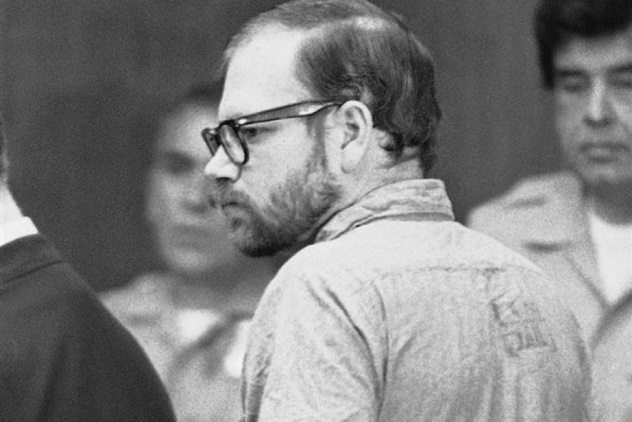
Most serial killers are solitary types. Roy Norris is an exception. In the late 1970s, he teamed up with another evil creep, Lawrence Sigmund Bittaker, to go on a rape and murder binge across Southern California. The two men, both then in their thirties, became friends in a state prison, where they shared their fantasies about assaulting teenage girls.
By 1979, both had been released. They teamed up, bought a GM cargo van, and set out to make their fantasies real. Within a few months’ time, they had abducted, raped, and murdered at least five teenage girls along the Pacific Coast Highway. The victims suffered horrific abuse before they died.
When investigators searched the cheap motel room Norris called home, they found Polaroid pictures of the victims and tape recordings of girls screaming in distress. Facing the death penalty, Norris made a deal with prosecutors. He pleaded guilty and testified against Bittaker in exchange for a life sentence. In the end, Bittaker was sentenced to lethal injection, but three decades later, he remains on death row awaiting execution. Norris is still locked up, too.
In prison, the two discovered that serial killers have fans. Some folks are fascinated by murder, binging on true crime books and horror movies and writing to killers behind bars. Some even collect souvenirs—dubbed “murderabilia”—such as autographs, prisoner artwork, and even cigarette butts and worn socks prisoners have cast aside.
The collecting mania has spawned a small industry. Entrepreneurs write to convicted killers, offering to deposit funds in prison canteen accounts in exchange for their artwork and other items. They sell the stuff on websites with names like Murder Auction and Supernaught.com.
Bittaker has cashed in by making greeting cards. Norris apparently lacks artistic talent, so he sells a bit of himself: his nail clippings, for the bargain price of $9.99. On at least one occasion, he mailed his clippings taped to a Christmas card, with the admonition: “As long as don’t end up in the hands of a Haitian Voodoo Priest.”[10]
Instead, they ended up in the hands of Andy Kahan, a victims’ advocate for Texas courts. He now uses Norris’s nails and a few other murder souvenirs to make presentations to state legislatures. To date, he’s convinced five states to bar inmates from making money off their crimes, and eBay has banned the trade.
Joe Arimathea has all his body parts.
Read about more body parts that ended up somewhere other than the grave on 10 Body Parts That Went On Adventures Alone and Top 10 World Famous Human Body Parts.
